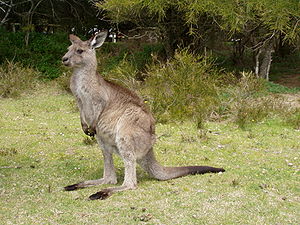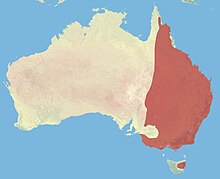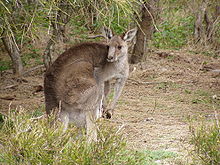Eastern gray giant kangaroo
| Eastern gray giant kangaroo | ||||||||||||
|---|---|---|---|---|---|---|---|---|---|---|---|---|

Eastern gray giant kangaroo |
||||||||||||
| Systematics | ||||||||||||
|
||||||||||||
| Scientific name | ||||||||||||
| Macropus giganteus | ||||||||||||
| Shaw , 1790 |
The eastern gray giant kangaroo ( Macropus giganteus ) is a species of marsupial from the kangaroo family (Macropodidae). It is the second largest representative of this group after the red giant kangaroo .
description
Eastern gray kangaroos are large animals. They reach 85 to 140 centimeters head body length, the powerful tail is another 75 to 100 centimeters long. Males are often twice as heavy as females and can weigh up to 55 kilograms. Like all kangaroos, they have muscular hind legs, short front legs and an elongated head with large ears. Their coarse, dense fur is silver-gray, with animals on the coasts usually being lighter in color than animals in the interior.
distribution and habitat
Eastern gray kangaroos inhabit all of east and south-east Australia including the island of Tasmania . They live in a range of habitats, including open forests and grasslands, but also wooded mountainous areas.
behavior
These animals are predominantly crepuscular or nocturnal, during the day they often rest in the shade. They are very faithful to their location and rarely leave their territory, even in times of drought. Territorial behavior is not pronounced.
Like many other kangaroos, giant kangaroos have two modes of locomotion. When foraging for food, they move on all fours, rely on their short front legs and graze the ground. At high speed they only hop with their hind legs in the familiar way, the tail is used for balance.
These kangaroos live in small groups of ten to thirty animals. These consist of several males and females as well as the offspring and are an unorganized, loose association of animals that is often not very durable. By fighting, the males establish a hierarchy that is particularly important during reproduction.
food
Eastern gray kangaroos feed on plants, primarily grass and, to a lesser extent, leaves. They also eat fruit in captivity, but this behavior has not been observed in the wild. A multi-chambered stomach and special microorganisms in the digestive tract help digest food.
Reproduction
These kangaroos have a well developed pouch with four teats. The gestation period is around 36 days, and most newborns are born in spring when the food supply is greatest. As a rule, single births predominate. Sometimes the birth is delayed, the female mates again shortly after birth, but the embryo does not grow until the previous newborn is weaned or dies.
The development of the young animal takes a very long time. It comes out of the bag for the first time after 280 days and leaves it continuously after 320 days. It is weaned at around 18 months and sexually mature at 20 months. Life expectancy is estimated at seven to ten years in the wild, but in individual cases they can also be twenty years and older.
Systematics
This species belongs to the genus Macropus , which also includes the red giant kangaroo , wallabies and mountain kangaroos . Its closest relative is the similar but slightly smaller Western Gray Giant Kangaroo .
threat
Adult animals have hardly any natural enemies, young animals sometimes fall prey to dingoes or birds of prey . Their only serious threat is humans. However, like all large species of kangaroo, the arrival of Europeans has affected them less than smaller species. They are hunted for their meat and sometimes for their fur, but the hunt is strictly regulated. They have disappeared from some densely populated regions, otherwise they have been able to retain their settlement area. The Eastern Gray Giant Kangaroo is not on the endangered species list.
The species is kept in several German zoos.
literature
- Udo Gansloßer (Ed.): The kangaroos. Filander, Fürth 1999, ISBN 3-930831-30-9 .
- Ronald Strahan: Mammals of Australia. Smithsonian Books, Washington DC 1996, ISBN 1-56098-673-5 .
- Ronald M. Nowak: Mammals of the World. Johns Hopkins University Press, Baltimore 1999, ISBN 0-8018-5789-9 .
Web links
- Macropus giganteus in the endangered Red List species the IUCN 2006. Posted by: Australasian Marsupial & Monotreme Specialist Group, 1996. Retrieved on 10 May, 2006.
- Video: Macropus giganteus (Macropodidae) - modes of movement . Institute for Scientific Film (IWF) 1967, made available by the Technical Information Library (TIB), doi : 10.3203 / IWF / E-1064 .
Individual evidence
- ↑ Eastern Gray Giant Kangaroo Zoo Animal List, accessed on March 12, 2020



